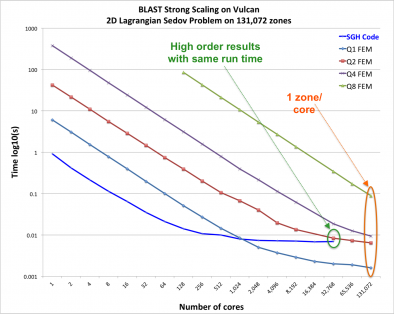Through research funded at LLNL, scientists have developed BLAST, a high-order finite element hydrodynamics research code that improves the accuracy of simulations and provides a viable path to extreme parallel computing and exascale architectures.
High-order finite element methods use additional degrees of freedom per computational element (or zone) to increase the accuracy and robustness of simulations relative to low-order methods, which have historically been used. For example, in the image above, a very high-order calculation of a multi-material shock hydrodynamics problem is shown using Q8–Q7 finite elements (eighth-order polynomials for the kinematic fields, seventh-order polynomials for the thermodynamic fields). The high-order finite elements result in highly curved zones and subzonal resolution of the shock waves, which is simply not possible with a low-order method.
BLAST also provides a high performance computing advantage since high-order methods have greater flop/byte ratios, meaning that more time is spent on floating point operations relative to memory transfer, an important characteristic of numerical algorithms for exascale computing. Strong scaling data for the BLAST code on the Sequoia machine is shown above.
Because high-order methods are more compute intensive at the zone level, the communication overhead is not as significant as it is for low-order algorithms; thus, it is possible to achieve excellent strong scaling results all the way down to the limit of a single computational zone per processor.
BLAST solves the Euler equations of compressible hydrodynamics using an arbitrary Lagrangian-Eulerian (ALE) formulation based on Lagrange+Remap phases.
Lagrangian Phase
- Solve the Euler equations on a moving curvilinear mesh
- High-order continuous basis for kinematic fields
- High-order discontinuous basis for thermodynamics fields
Remesh/Remap Phase
- Curvilinear mesh optimization
- High-order harmonic or inverse-harmonic smoothing algorithms
- Solving advection equations using high-order discontinuous Galerkin (DG) methods
- Conservative and monotonic field transfer
Software
- BLAST Object-oriented high-order finite element shock hydrocode
- MFEM Modular finite element discretization library
- GLVis OpenGL visualization tool
Results
- Triple-Point Shock Interaction
- Rayleigh-Taylor Instability
- ICF-Like Implosion
- Elastic-Plastic Flow
- Parallel Performance
News
See also the Team and Publications pages for more information about BLAST.
- Initial version of libCEED the low-level CEED API released (Dec, 2017)
- MFEM version 3.3.2 released (Nov, 2017)
- Laghos miniapp part of CORAL-2 Benchmarks and ECP’s Proxy Apps Suite (Nov, 2017)
- Postdoc position available for electromagnetic simulations with MFEM (Oct, 2017)
- First release of the Laghos miniapp, a proxy for BLAST developed in CEED (May, 2017)
- News highlight: "Accelerating Simulation Software with Graphics Processing Units" (May, 2017)
- MFEM version 3.3 and GLVis version 3.3 released (Jan, 2017)
- MFEM part of the new Exascale Computing Project co-design Center for Efficient Exascale Discretizations (CEED) (Nov, 2016)
- LLNL Newsline: Lawrence Livermore tapped to lead ‘co-design’ center for exascale computing ecosystem (Nov, 2016)
- Science & Technology Review article: Laying the Groundwork for Extreme-Scale Computing, see also the YouTube preview (Oct, 2016)
- MFEM version 3.2 and GLVis version 3.2 released (Jun, 2016)
- MFEM version 3.1 and GLVis version 3.1 released (Feb, 2016)
- BLAST and MFEM simulation images in the "Art of Science" exhibition at the Livermore public library (Feb 5, 2016)
- News highlight: "High-Order Finite Element Library Provides Scientists with Access to Cutting-Edge Algorithms" (Jan, 2016)
- LLNL Laboratory Directed Research and Development Annual Report (2015)
- MFEM and GLVis repositories moved to GitHub: mfem.org and glvis.org (Aug, 2015)
- MFEM version 3.0 and GLVis version 3.0 released (Jan, 2015)
- News highlight: "Remapping Algorithm Boosts BLAST Simulations" (Jan, 2015)
- LLNL Laboratory Directed Research and Development Annual Report (2014)
- LLNL Computation Directorate Annual Report (2014)
- NNSA Office of Advanced Scientific Computing eNews (Mar, 2013)
- NNSA LDRD Symposium (2011)



